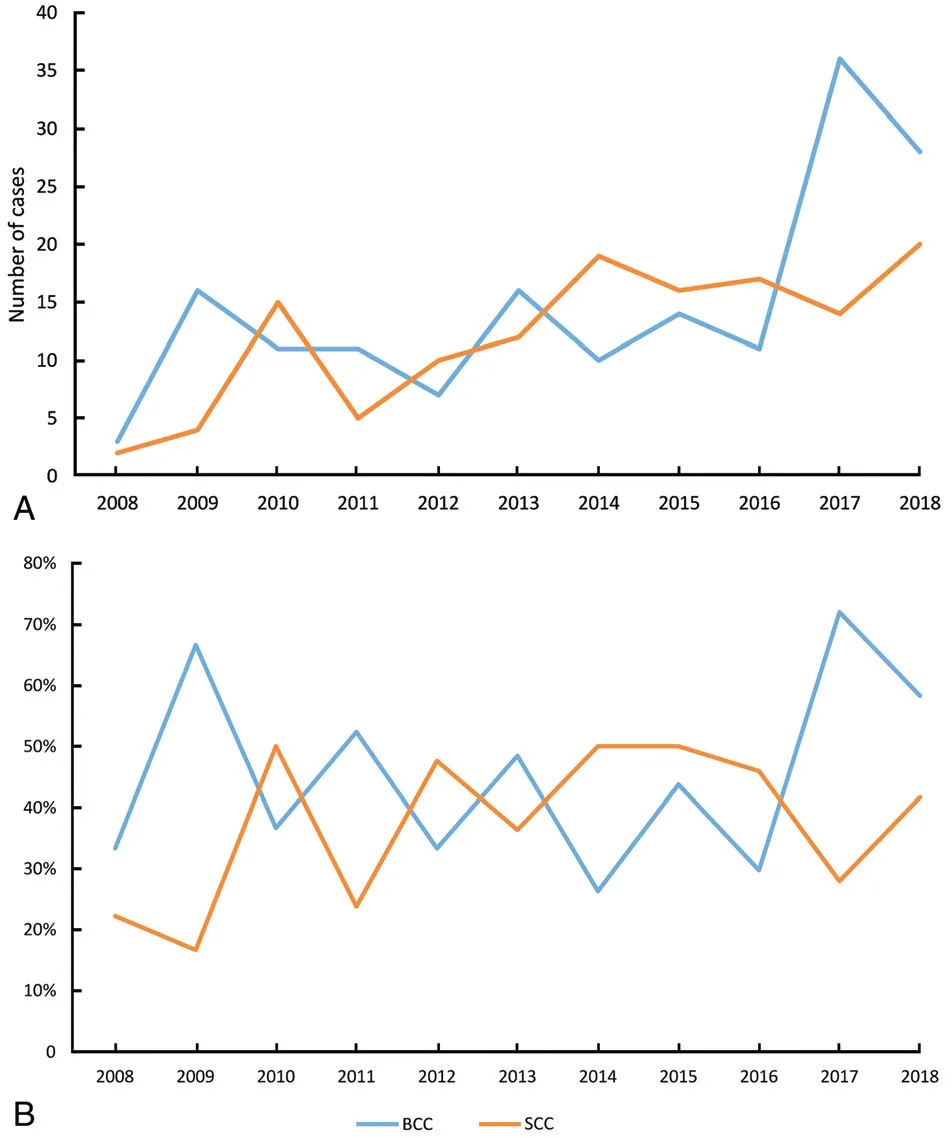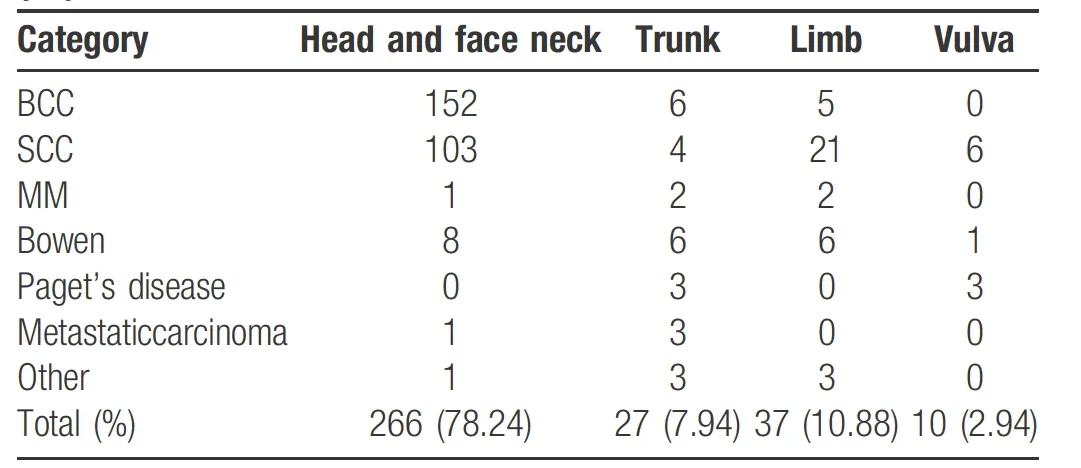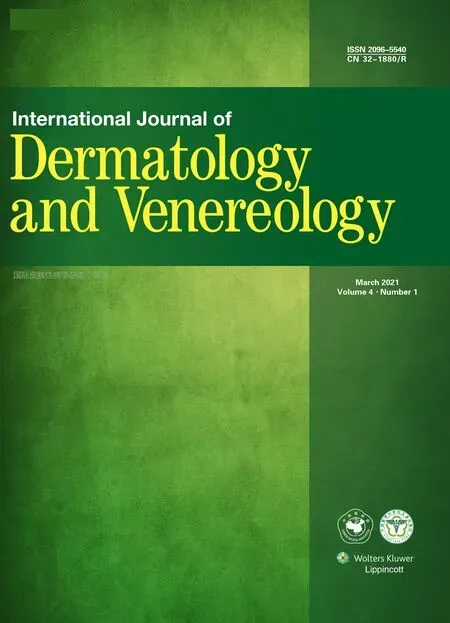A Clinical Retrospective Analysis of 340 Inpatients With Malignant Skin Tumors in Western Inner Mongolia
Min-Xin Jia, Dong-Xia Li∗, Yu-Lei Liu
Department of Dermatology, Affiliated Hospital of Inner Mongolia Medical University, Hohhot, Inner Mongolia 010100, China.
Abstract
Objective: This study was performed to evaluate the clinical and epidemiological characteristics of inpatients with malignant skin tumors in western Inner Mongolia during the past 10 years.
Methods: We collected the clinical data of inpatients with histopathologically diagnosed malignant skin tumors admitted to the Affiliated Hospital of Inner Mongolia Medical University from June 2008 to December 2018. Morbidity was compared using the Chi-square test.
Results: In total, 340 inpatients with malignant skin tumors were evaluated, including 163 (47.94%) patients with basal cell carcinoma, 134 (39.41%) with squamous cell carcinoma, 5 (1.47%) with malignant melanoma, 21 (6.18%)with Bowen disease, and 6 (1.76%) with Paget’s disease. Four (1.18%) patients had metastatic skin cancer and seven(2.06%) had other malignant skin tumors. The patients comprised 132 (38.8%) men and 208 (61.1%) women, and there were no statistically significant sex-related differences among the skin malignancies (x2=5.006, P>0.05). Among the 340 patients, 314 (92.4%) were of Han nationality and 26 (7.6%) were of ethnic minorities. Statistically significant differences were found in the various types of malignant skin tumors between the Han and minority groups (x2=19.446,P<0.05). Among the selected patients, 61.76% were farmers and herdsmen, and the sites mainly affected were the head, face, neck, trunk, limbs, and vulva.
Conclusion: The incidence of malignant skin tumors in western Inner Mongolia has substantially increased during the past decade, especially in the past 2 years. Therefore, we should increase the awareness of prevention and treatment of malignant skin tumors to achieve early diagnosis and treatment effects.
Keywords: retrospective analysis, malignant skin cancer, inner Mongolia
Introduction
Skin malignancies are the most common malignanttumors,and their worldwide incidence has substantially increased in recent years.1The incidence of malignant skin tumors is also increasing in some specific areas in China,such as Tianjin, North Guangxi, Chongqing, Handan, and Hebei.2–5However no data of the Inner Mongolia were reported, so we conducted this retrospective study from June 2008–December 2018 on the epidemiology and clinical features of malignant skin tumors in this special geographical region. This study may improve the understanding of malignant skin tumors and provide clinical experience for early diagnosis and treatment.
Materials and methods
Patients
The medical data were collected from 340 inpatients with histopathologically diagnosed malignant skin tumors treated from June 2008 to December 2018 in the Department of Dermatology, Affiliated Hospital of Inner Mongolia Medical University. The exclusion criteria were as follows: first diagnosis attained beyond the timeline of the study, incomplete case data or unclear histopathological diagnosis, and many readmissions to the hospital for treatment or re-examination after the diagnosis. For patients who underwent more than one pathological examination, only the first diagnosis was recorded.
The medical data for all eligible inpatients were collected, including sex, age, occupation, nationality,long-term residence, tumor location, number of tumors,diagnostic results, treatment methods, and other data.The disease sites were divided into the head, face, neck,trunk, limbs, and vulva. The study met the Declaration of Helsinki.
Statistical analysis
The collected data were compiled into an Excel table(Microsoft Corp., Redmond, WA, USA), and the statistical analysis was performed using SPSS 22 software (IBM Corp., Armonk, NY, USA). Quantitative data are expressed as mean±standard deviation, and qualitative data are expressed as frequency and percentage. Morbidity was compared using the Chi-square test. When the test showed an α value of 0.05 and P-value of <0.05, the difference was considered statistically significant.
Results
Classification of malignant skin tumors
A total of 340 inpatients with skin malignancies were selected according to the inclusion criteria. Among these 340 patients, 163 (47.94%) had basal cell carcinoma(BCC), 134 (39.41%) had squamous cell carcinoma(SCC), 5 (1.47%) had malignant melanoma (MM), 21(6.18%) had Bowen disease, 6 (1.76%) had Paget’s disease(3 [0.88%] with mammary Paget disease and 3 [0.88%]with extramammary Paget disease), 4 (1.18%) had skin metastasis, and 7 (2.06%) had other skin malignancies (5[1.47%] with mycosis fungoides, 1 [0.29%] with angiosarcoma, and 1 [0.29%] with Kaposi sarcoma).BCC and SCC were the main skin diseases (87.35%).There was a wavelike increasing trend in the number of cases from 2008 to 2018, especially in the most recent 2 years (Fig. 1A). The number of cases of BCC and SCC accounted for the main proportion of the total number of malignant skin tumors, and there was an increasing trend in these tumor types as well (Fig. 1B).
Age, sex, and ethnic distribution
The 340 patients comprised 132 (38.8%) men and 208(61.1%) women with a male:female ratio of 0.63:1.00.There were no significant sex-related differences among the malignant skin tumors (x2=5.006, P>0.05). The patients’ ages ranged from 31 to 106 years, with a mean age at diagnosis of 69.81±12.59 years. Among the 163 patients with BCC, the mean age was 67.68±12.54 years and the proportion of women was 63.8%. Among the 134 patients with SCC, the mean age was 73.13±12.72 years and the proportion of women was 59.7%. All three patients with mammary Paget’s disease were female, and all three patients with extramammary Paget’s disease were male. Two male and two female patients had metastatic skin cancers. Among the five patients with mycosis fungoides, three were male and two were female. Both patients with angiosarcoma and the one patient with Kaposi sarcoma were male. The cohort comprised 314(92.4%) patients of Han nationality and 26 (7.6%) of minority nationalities. There were statistically significant differences in the various types of malignant skin tumors between the Han and minority nationalities (x2=19.446,P<0.05) (Table 1).

Figure 1. The incidence of skin malignancies from 2008–2018. A:Numbers of patients BCC and SCC. B: Proportions of patients with BCC and SCC. BCC: basal cell carcinoma; SCC: squamous cell carcinoma.
Occupational distribution
The selected patients included 210 (61.76%) farmers and herdsmen, 26 (7.65%) labors, 32 (9.41%) civil servants,25 (7.35%) company employees, 23 (6.76%) patients with Self-employed person, and 24 (7.06%) patients with other occupations.
Distribution and number of tumors
Among the 340 patients, the main lesion site was the head followed by neck, trunk, limbs, and vulva. A total of 266(78.24%) patients had lesions located on the head and face, 37 (10.88%) on the extremities, 27 (7.94%) on the trunk, and 10 (2.94%) on the vulva. The statistics of the affected sites are shown in Table 2. The number of tumors was 1 in 315 (92.65%) patients, 2 in 12 patients, 3 in 4 patients, 4 in 2 patients, and >4 in 5 patients.

Table 1 Sex, age, and nationality of patients with skin cancer.
Treatment
A total of 283 (83.24%) patients underwent surgical resection (lesion resection in 26, enlarged flap resection and repair in 155, and an expanded skin graft in 102), 15 patients underwent radiotherapy and chemotherapy(radiotherapy in 11 and chemotherapy in 4), seven patients underwent surgery and photodynamic therapy,16 patients were transferred to a referral hospital treatment, 17 patients did not undergo surgery for personal choices or because their conditions did not allow for surgery, and two patients died. Details are shown in Table 3.
Discussion
The Affiliated Hospital of Inner Mongolia Medical University is the largest third-level hospital in the region with a annual number of outpatients of 130,000. Most patients with difficult-to-manage and serious conditions are concentrated in our hospital. Therefore, the present study can reflect the epidemiology and clinical features of skin malignant tumors in this region
The present study showed a gradual increase of malignant skin tumors in western Inner Mongolia from 2008 to 2018, especially in the latter 2 years. This is related to the aging of society, increasing public health awareness,and greater recognition of the importance of skin-related diseases in China. It is also related to the rapiddevelopment of skin pathology and dermatological surgery in our hospital.

Table 2 Diseases distribution of patients with skin malignancies, n(%).
This study showed that the incidences of BCC and SCC was the highest top ones among all malignant skin tumors(see Table 1), followed by Bowen disease. These findings are consistent with previously reported results.6-7Most patients with malignant skin tumors in this study were women, however there were no statistically significant sex-related differences among the diseases (x2=5.006,P>0.05). This finding is inconsistent with the results reported by Guangdong.8Studies performed in other geographical regions have also shown that the incidence of malignant skin tumors is higher in men than in women,which may be related to the small number of patients analyzed. Women tend to pay more attention to skinrelated diseases and regional ethnic factors than do men,which help the early diagnosis and treatment of skin diseases. In the present study, except the mean age of the patients with MM was 56.40±4.39 years, the patients with other malignant skin tumors were all >60 years of age, suggesting that doctors should pay attention to the elderly patients. At the same time, we must be highly alert to the occurrence of MM in young and middle-aged patients.
Of the 340 patients in the present study, 314 (92.4%)were of Han nationality and 26 (7.6%) were of ethnic minorities. There were statistically significant differences in the distribution of the malignant skin tumors between the Han and minority groups (x2=19.446, P<0.05). This result is different from the findings of the Xinjiang region reported by Quinn and Perkins.9Whether this discrepancy is due to the differences between ethnic groups caused by different geographical locations, or the data offset caused by different research methods and target populations,there is still a need for further research and clarification.Most of the skin malignancies in the present study were single lesions. Studies have shown that ultraviolet radiation is an important factor affecting the development ofBCCand SCC.10-11BCC and SCC are more likely to occur in lightexposed areas such as the head, face, and neck, whileMMis more common in the trunk and extremities, especially the hands, feet, and soles. Bowen disease is more common in the head and neck, and the relevant literature reports areconsistent on this issue.12With respect to the occupational distribution, farmers and herdsmen accounted for 61.76%of the patients in the present study, which may be related to the long-term exposure of such individuals to strong ultraviolet rays and the failure to use appropriate protective measures. The Inner Mongolia Autonomous Region is located on a plateau with high ultraviolet intensity and a long sunshine duration. In addition to the close relationship between malignant skin tumors and ultraviolet rays, an individual’s environment, exposure to chemicals, and genetic background are also risk factors. In the present study, 83.24% of patients underwent surgical resection.According to the location, size, and depth of tumor invasion,the most common surgical methods were lesion resection,an expanded resection flap for metastasis, and an expanded resection skin graft. Radiotherapy was performed in 11 patients because of the particular location of the tumor, four patients with mycosis granulomatosis were treated with interferon chemotherapy, seven patients were recommended to undergo photodynamic therapy after a comprehensive preoperative evaluation, and three patients chose to be transferred to a referral hospital treatment or discontinue treatment. One patient died of multiple metastases from breast cancer, and one died of multiple organ involvement and failed treatment for Kaposi sarcoma.

Table 3 Treatment methods for skin cancers, n(%).
In summary, BCC and SCC were the main tumors among hospitalized patients with malignant skin tumors in western Inner Mongolia, and they were more likely to occur in elderly patients. Ultraviolet radiation was a key risk factor. Therefore, the prevention and awareness of malignant skin tumors should be strengthened and efforts should be made to increase the popularization of science.For suspicious lesions in light-exposed parts of the head,face, and neck of elderly patients or on the limbs, early histopathological examination should be performed to confirm the diagnosis, and early diagnosis and treatment should be performed to improve the cure rate of malignant tumors.
- 国际皮肤性病学杂志的其它文章
- Circulating MicroRNAs as Potential Biomarkers in the Diagnosis of Neurosyphilis: A Case Control Study
- NCSTN Gene Silencing Inhibits the Retinoic Acid Signaling Pathway in Human Immortalized Keratinocytes
- Subepidermal Autoimmune Bullous Disease Associated With Monoclonal Gammopathy of Unknown Significance and Unexpected Positive Direct Nikolsky Phenomenon: A Case Report
- Nicolau Syndrome Following Metamizole Injection: A Case Report
- A Study of Normal Epidermal Melanocyte Distribution
- Erosive Pustular Dermatosis of the Scalp After Excision and Skin Grafting of Scalp Squamous Cell Carcinoma

